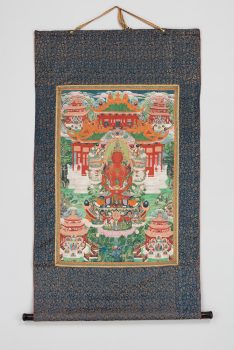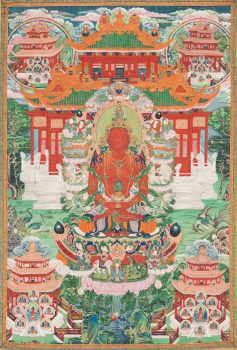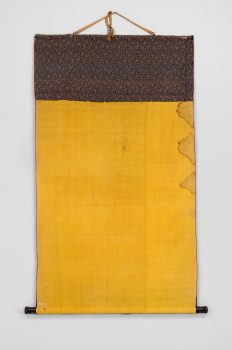Inner Mongolia
19th century



Inner Mongolia
19th century



This painting is a fine example of the cross‑fertilization of Tibetan Buddhism and Chinese aesthetics. Buddha Amitayus is shown seated on a lotus in front of an elegant Chinese palace. The artist closely observed imperial architectural style—lion heads carved on the posts of white marble balustrades, changing colors on inset panels between railings, marble plinths in profile—suggesting that they werefamiliar with Chinese buildings. The palaces at the four corners of the composition were common structures in later imperial garden settings. The arrangement of these surrounding palaces creates a sense of perspective.In the center of this composition sits Buddha Amitayus, the Buddha of Infinite Life, on a Chinese-style seat. In front of him a lotus blossom and its branches carry a king and his auspicious “Seven Jewels.” Amitayus presides over a paradisiacal realm with a two-story palace behind him, the roof tiles of which carry the six syllable mantra of Avalokiteshvara. The palaces in the corners of the painting represent realms similar to the central one and are situated at the cardinal directions around it. Each of them is occupied by an assembly of eight deities from the mandala of Amitayus.
A state of “waking up” from illusion and seeing the true nature of reality. Buddha Shakyamuni attained enlightenment while meditating under the bodhi tree. Buddhist teaching explains that the accumulation of merit and wisdom are essential for achieving enlightenment, also known as awakening.
A vehicle for the preservation and transmission of knowledge. The Buddha’s teachings were originally passed down through oral transmission and storytelling, and stories of the Buddha’s past lives are considered an important source of inspiration and guidance.
A meditation technique primarily used in tantric practice that involves imagining a deity in one’s mind or imagining oneself becoming a deity and carrying out various activities. Such techniques are intended to help a practitioner transform ordinary perception and achieve enlightened qualities.
An awakened being who understands the true nature of reality and is free from the cycle of birth, death, and rebirth. While there are many buddhas, Siddhartha Gautama is the historical Buddha, whose teachings became the foundation of Buddhism.
Mongolians have been widely active in the Tibetan Buddhist world, playing a key role in Tibetan culture, politics, and relations with China. In the 13th century, the Mongol Empire—the largest contiguous empire in world history—facilitated the spread of Tibetan visual culture.
Get the latest news and stories from the Rubin, plus occasional information on how to support our work.